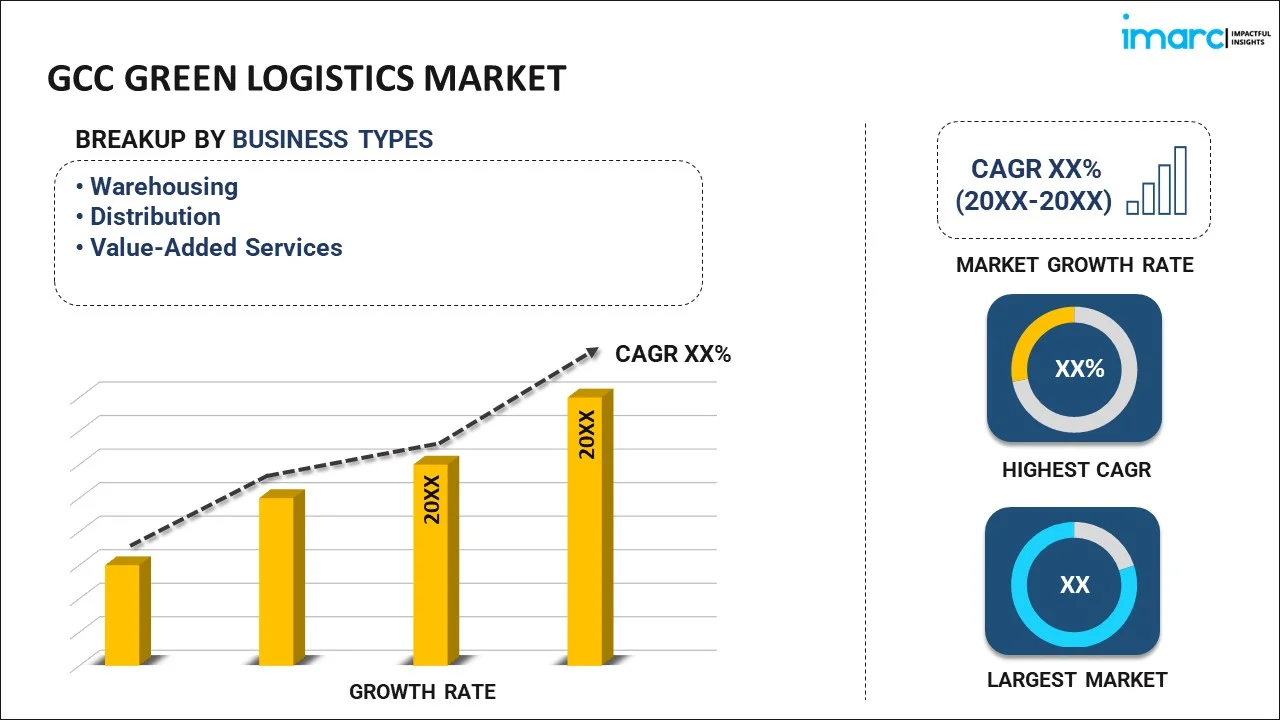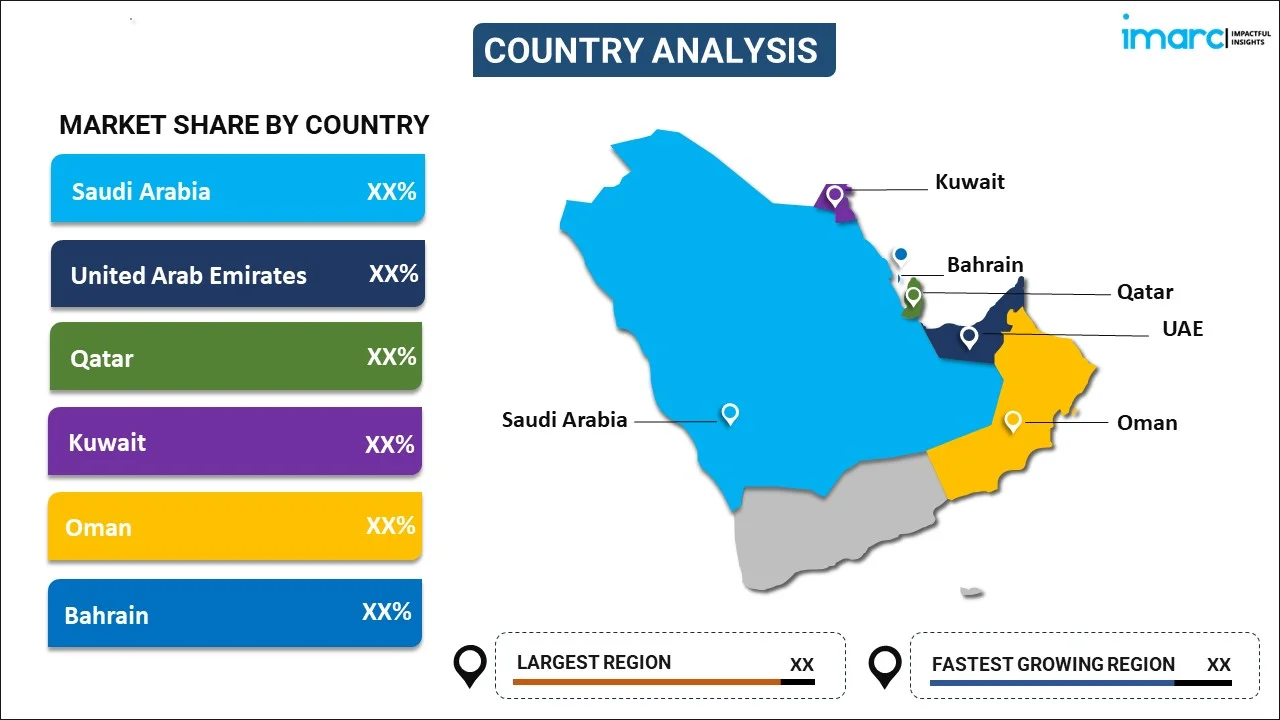
GCC Green Logistics Market Report by Business Type (Warehousing, Distribution, Value-Added Services), Mode of Operation (Storage, Roadways Distribution, Seaways Distribution, and Others), End Use Industry (Retail Consumer Goods, Semiconductor and Electronics, Chemical and Material, Automotive, Energy and Utilities, Healthcare, and Others), and Country 2025-2033
Market Overview:
The GCC green logistics market size reached USD 29.3 Billion in 2024. Looking forward, IMARC Group expects the market to reach USD 76.8 Billion by 2033, exhibiting a growth rate (CAGR) of 11.2% during 2025-2033. The increasing awareness of climate change, growing stringent government regulations, rapid technological advancements, rising sustainability concerns and increasing investment in renewable energy sources represent some of the key factors driving the market.
|
Report Attribute
|
Key Statistics
|
|---|---|
|
Base Year
|
2024 |
|
Forecast Years
|
2025-2033
|
|
Historical Years
|
2019-2024
|
| Market Size in 2024 | USD 29.3 Billion |
| Market Forecast in 2033 | USD 76.8 Billion |
| Market Growth Rate (2025-2033) | 11.2% |
Green logistics refers to the application of sustainable practices within supply chain management aimed at reducing the negative environmental impact of logistics activities. It incorporates eco-friendly transport solutions, optimized route planning, energy-efficient warehousing, and waste management techniques. Green logistics operations are often recyclable, and efforts are made to minimize emissions, water usage, and energy consumption. The practice finds wide-ranging applications across various sectors, including manufacturing, retail, healthcare, and agriculture. It offers multiple benefits, such as reduced operational costs due to energy savings, regulatory compliance, and enhanced corporate reputation. Moreover, green logistics helps to minimize the environmental impact of logistics activities, such as reducing carbon emissions, optimizing fuel efficiency, and using sustainable packaging materials.
GCC Green Logistics Market Trends:
The increasing awareness of climate change, prompting companies to reevaluate their supply chains and adopt green logistics solutions, is one of the major factors contributing to the market growth. Additionally, the growing stringent government regulations focusing on carbon emissions and waste management compelling businesses to implement sustainable practices is providing a thrust to the market growth. Besides this, rapid technological advancements like artificial intelligence (AI) and the Internet of Things (IoT) facilitating better route optimization and real-time tracking, which contribute to energy savings, are creating a positive outlook for market growth. Moreover, the significant growth in the e-commerce sector, leading to an increasing demand for efficient and sustainable logistics solutions, is providing an impetus to the market growth. In addition to this, the rising fuel costs motivating companies to look for eco-friendly alternatives in transportation and operations is strengthening the market growth. Apart from this, the rising scarcity of natural resources making waste reduction and resource optimization imperative and encouraging businesses to shift toward green logistics is supporting the market growth. Furthermore, the growing investment in renewable energy sources within the GCC region, along with continuous innovation and research in creating more eco-friendly logistics solutions, is providing remunerative growth opportunities for the market. Besides this, the development of new technologies, such as electric vehicles (EVs), renewable energy sources, and advanced logistics software, are presenting remunerative growth opportunities for the market. Other factors, including the growing importance of corporate social responsibility to reduce environmental impact, rising environmentally conscious customers and enhanced focus on research and development (R&D) activities, are supporting the market growth.
GCC Green Logistics Market Segmentation:
IMARC Group provides an analysis of the key trends in each segment of the GCC green logistics market report, along with forecasts at the regional and country levels for 2025-2033. Our report has categorized the market based on business type, mode of operation and end use industry.
Business Type Insights:

- Warehousing
- Distribution
- Value-Added Services
The report has provided a detailed breakup and analysis of the market based on the business type. This includes warehousing, distribution, and value-added services.
Mode of Operation Insights:
- Storage
- Roadways Distribution
- Seaways Distribution
- Others
A detailed breakup and analysis of the market based on the mode of operation has also been provided in the report. This includes storage, roadways distribution, seaways distribution, and others.
End Use Industry Insights:
- Retail Consumer Goods
- Semiconductor and Electronics
- Chemical and Material
- Automotive
- Energy and Utilities
- Healthcare
- Others
A detailed breakup and analysis of the market based on the end use industry has also been provided in the report. This includes retail consumer goods, semiconductor and electronics, chemical and material, automotive, energy and utilities, healthcare, and others.
Country Insights:

- Saudi Arabia
- UAE
- Qatar
- Bahrain
- Kuwait
- Oman
The report has also provided a comprehensive analysis of all the major regional markets, which include Saudi Arabia, UAE, Qatar, Bahrain, Kuwait, and Oman.
Competitive Landscape:
The report has also provided a comprehensive analysis of the competitive landscape in the market. Competitive analysis such as market structure, key player positioning, top winning strategies, competitive dashboard, and company evaluation quadrant has been covered in the report. Also, detailed profiles of all major companies have been provided.
GCC Green Logistics Market Report Coverage:
| Report Features | Details |
|---|---|
| Base Year of the Analysis | 2024 |
| Historical Period | 2019-2024 |
| Forecast Period | 2025-2033 |
| Units | Billion USD |
| Scope of the Report | Exploration of Historical and Forecast Trends, Industry Catalysts and Challenges, Segment-Wise Historical and Predictive Market Assessment:
|
| Business Types Covered | Warehousing, Distribution, Value-Added Services |
| Mode of Operations Covered | Storage, Roadways Distribution, Seaways Distribution, Others |
| End Use Industries Covered | Retail Consumer Goods, Semiconductor and Electronics, Chemical and Material, Automotive, Energy and Utilities, Healthcare, Others |
| Countries Covered | Saudi Arabia, the UAE, Qatar, Bahrain, Kuwait, Oman |
| Customization Scope | 10% Free Customization |
| Post-Sale Analyst Support | 10-12 Weeks |
| Delivery Format | PDF and Excel through Email |
Key Questions Answered in This Report:
- How has the GCC green logistics market performed so far and how will it perform in the coming years?
- What has been the impact of COVID-19 on the GCC green logistics market?
- What is the breakup of the GCC green logistics market on the basis of business type?
- What is the breakup of the GCC green logistics market on the basis of mode of operation?
- What is the breakup of the GCC green logistics market on the basis of end use industry?
- What are the various stages in the value chain of the GCC green logistics market?
- What are the key driving factors and challenges in the GCC green logistics market?
- What is the structure of the GCC green logistics market and who are the key players?
- What is the degree of competition in the GCC green logistics market?
Key Benefits for Stakeholders:
- IMARC’s report offers a comprehensive quantitative analysis of various market segments, historical and current market trends, market forecasts, and dynamics of the GCC green logistics market from 2019-2033.
- The research study provides the latest information on the market drivers, challenges, and opportunities in the GCC green logistics market.
- Porter's five forces analysis assist stakeholders in assessing the impact of new entrants, competitive rivalry, supplier power, buyer power, and the threat of substitution. It helps stakeholders to analyze the level of competition within the GCC green logistics industry and its attractiveness.
- Competitive landscape allows stakeholders to understand their competitive environment and provides an insight into the current positions of key players in the market.
Need more help?
- Speak to our experienced analysts for insights on the current market scenarios.
- Include additional segments and countries to customize the report as per your requirement.
- Gain an unparalleled competitive advantage in your domain by understanding how to utilize the report and positively impacting your operations and revenue.
- For further assistance, please connect with our analysts.
 Inquire Before Buying
Inquire Before Buying
 Speak to an Analyst
Speak to an Analyst
 Request Brochure
Request Brochure
 Request Customization
Request Customization




.webp)




.webp)












